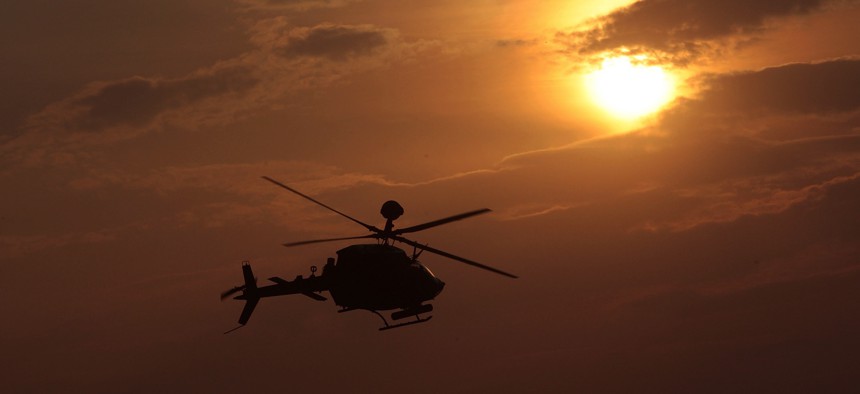
In this 2009 photo, an OH-58 Kiowa helicopter flies in Kandahar Province, Afghanistan. Chris Hondros/Getty Images
In shakeup, Army cancels planned scout helo, will retire two drones
After sinking nearly $2 billion into the FARA program, service leaders decide "enduring, unmanned, and space-based assets" would do the job better.
The Army will cancel its multi-billion dollar Future Attack Reconnaissance Aircraft, or FARA, program, officials said Thursday, announcing a slew of aviation-acquisition changes.
The planned scout helicopter is being scuttled to “meet emerging capability requirements in a resource constrained environment,” Army officials said in a press release. “Army leaders assessed that the increased capabilities [FARA] offered could be more affordably and effectively achieved by relying on a mix of enduring, unmanned, and space-based assets.”
Last year, a MITRE report concluded that the Army would struggle to make FARA unmanned before 2040.
“How we do reconnaissance is going to adjust,” thanks to unmanned systems, Army Chief of Staff Gen. Randy George said at an AUSA event earlier this week.
FARA, which the Army once called its top aviation priority and its No. 3 acquisition priority overall, was supposed to fill the hole left when the OH-64 Kiowa was retired in 2020. The Army had already spent nearly $2 billion on FARA, and planned to spend a total of $20 billion to buy up to 400 of the helicopters. In October, it had delivered test engines to Sikorsky and Bell, which were vying to develop the aircraft.
Sikorsky, which had sought to offer a variant of its X2 helicopter, said in a statement, “We are disappointed in this decision and will await a U.S. Army debrief to better understand its choice.”
The Army will also “phase out operations and sustainment” of its aging RQ-7 Shadow drones, first fielded in combat in 2003. The surveillance UAV is literally a museum piece: at one point, one hung in the Smithsonian.
The propeller drones were unpopular with soldiers, panned as loud, slow-moving, and equipped with poor visual feeds. In 2021, one Army general was impressed that a drone being tested to replace the Shadow could fly in the rain.
In September, the Army selected Griffon and Textron to compete to build vertical-take-off-and-landing drones to replace the RQ-7.
The Army will also phase out its RQ-11 Raven, first fielded two decades ago. In 2016, Ukrainian operators of U.S-donated versions of the drone found that Russian forces could easily intercept and jam some versions of the drone, although later versions of the drones were jam-resistant.
In place of the Shadow and Raven, the Army will “increase investments in cutting-edge, effective, capable and survivable unmanned aerial reconnaissance capabilities and the procurement of commercial small unmanned systems,” the Army press release said.
“We are learning from the battlefield—especially in Ukraine—that aerial reconnaissance has fundamentally changed,” George said in the Army press release. “Sensors and weapons mounted on a variety of unmanned systems and in space are more ubiquitous, further reaching, and more inexpensive than ever before.”
The Army has multiple options for commercial drones, thanks to the Blue UAS list, which consists of drones that the U.S. has cleared for government purchase.
The Army needs to be adaptable with its drone purchasing, George said at AUSA. Rather than having these big programs, the Army should “have a funding line that says, 'Hey, let’s spend this amount of money on small UAS and have the ability to adapt',” he said.
Both Ukraine and Russia have made heavy use of cheap commercial drones for intelligence, targeting, and strikes. Ukraine has found drones so useful that this week it launched a new branch of its military exclusively focused on drone warfare.
Commercially available drones can be easier to fly than specialist models. Operators of surveillance drones in Ukraine, such as those that fly DJI-brand models, finish drone operator courses within as little as five days.
Other announcements made in the Army’s press release included ending production of the UH-60V version of the Blackhawk helicopter due to cost growth, commiting to a multi-year contract for the UH60M Blackhawk, and formally beginning production of the CH-47F Block II Chinook. The Army is also continuing the Future Long-Range Assault Aircraft (FLRAA).



